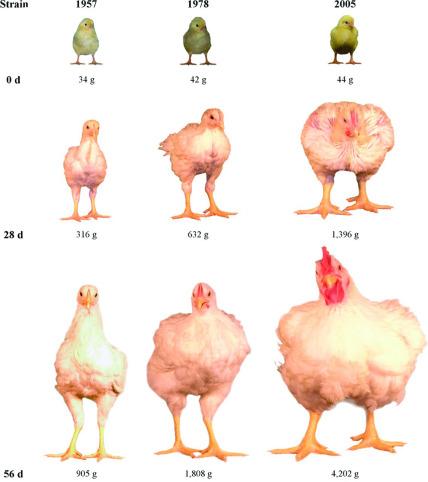Researchers from the University of Alberta, Canada, discovered that modern chickens are much larger than the ones from the 1950s. They measured three chickens, all the same age. The first one was a breed from 1957, weighing 905 grams. The second was a breed from 1978, and it weighed 1,808 grams.
Finally, the third was a breed called the Ross 308 broiler, which came about in 2005. It weighed a whopping 4,202 grams. The study in Poultry Science investigated these three chickens, all of which were raised and fed the same way, to understand what made them so different from each other. [1]
Chicken Breeds Are Bigger Than Ever
The 2005 chicken breed grew to over four times the size of the breed from 1957, and double the size of the one from 1978. These results were exactly what the authors of the study expected. “We had never actually tested our 1978 line before, but where they fell were very consistent with what we believed would be the case based on historical selection for growth rate and efficiency,” said Martin Zuidhof, one of the study’s authors. He’s also an associate professor at the University of Alberta and his research examines how nutrition, genetics, and other factors could affect the growth of poultry. [2]

Breeders have purposely worked to increase the size of chickens. According to the National Chicken Council, chickens would go to market after 70 days in 1955 and after 47 days in 2011. Despite the fewer days to grow, the average market weight of chickens has almost doubled, going from 3.07 pounds to 5.80 pounds.
The two breeds, the one from ‘57 and ‘78, have been continued for the sole purpose of recording the size of these birds from those times. So, researchers let them reproduce at random instead of selectively breeding them. “Basically, they’re a benchmark in time of what the commercial meat type chickens were in the years that the random breeding started,” Zuidhof said. Researchers also raise them in an environment and food identical to the original time period.

The study clearly shows that modern chickens grow faster and larger through selective breeding. In other words, the farmers pick the largest of the flock and have them mate with each other. But while this benefits the supply and demand for poultry, there are some negatives. Mainly, these larger chickens have more prevalent health problems.
“Twenty-five years ago was probably the low point in the industry in terms of negative consequences of selection,” Zuidhof said. “There were metabolic disorders, heart attacks, just difficulties that were associated with rapid growth.” Since then, breeders began to choose birds with stronger legs and healthier features instead of picking the largest of the flock. As a result, the chickens’ health issues are more manageable.
The Supply and Demand for Poultry
“There’s a lot of criticism or ignorance about why chicken grow so fast,” said Zuidhof. “If you look at a chicken from 50 years ago and today’s chicken, it’s natural to say, ‘Wow, what’s going on, that seems like something that’s pretty unnatural.’” However, he states that steroids, hormones, the like are not responsible for the increase in size. Rather, it’s because of how quickly chickens can reproduce.
Chickens could bear about 120 chicks a year and start breeding after 25 weeks. So selective breeding can occur more quickly, and the results are easily noticeable, unlike other livestock like cows, who may have only one calf a year. At the same time, the demand for poultry has grown, encouraging breeders to aim for bigger birds with more meat on them. This also increases chicken production without needing more feed to support it, making this method more cost-effective. [3]
In fact, the average American eats over four times the amount of chicken today than they ate in the early 1900s. And they particularly eat white meat. “If people keep eating more and more chicken, chickens will probably have to get even bigger,” said Dr. Michael Lilburn, a professor at Ohio State University’s Poultry Research Center. “We’ll have to increase the proportion of breast meat in each bird, too.” [4]
Despite the minority speaking out against breeding bigger chickens, the consumer demand speaks louder. Many people prefer to purchase healthy protein at lower prices, and the industry acts accordingly. However, it’s troubling to think about what chickens might look like down the line. “I don’t think we’ve seen the limit,” Lilburn said. “We’ll probably see a limit when we start getting into product quality issues, when the side-effects are too burdensome. But we aren’t there yet.”
Keep Reading: Lead and Cadmium Could Be in Your Dark Chocolate
Sources
- “Growth, efficiency, and yield of commercial broilers from 1957, 1978, and 2005.” Poultry Science. M.J. Zuidhof. December 2014
- “Chickens four times bigger than they used to be: study.” CTV News. Jesse Tahirali. October 6, 2014
- “Why chickens are twice as big today as they were 60 years ago.” Market Watch. Evie Liu. January 6, 2017
- “Look at what our obsession with white meat has done to chickens.” The Washington Post. Roberto A. Ferdman. March 12, 2015

